Did you know that some indoor plants do more than just add a splash of green to your home? They also help purify the air you breathe. Whether you’re an indoor gardener, a plant enthusiast, or someone eager to enhance your living space with greenery, air-purifying plants are both a practical and aesthetic choice. Here, we’ll introduce you to 17 of the best plants for improving indoor air quality.
Why Choose Air-Purifying Plants?
Indoor air can often become more polluted than outdoor air, thanks to dust, pet dander, and toxins from cleaning products or furniture. Plants naturally filter these impurities, making your home healthier. Plus, these green companions can boost your mood and add a touch of life to your space.
1. Snake Plant (Sansevieria)
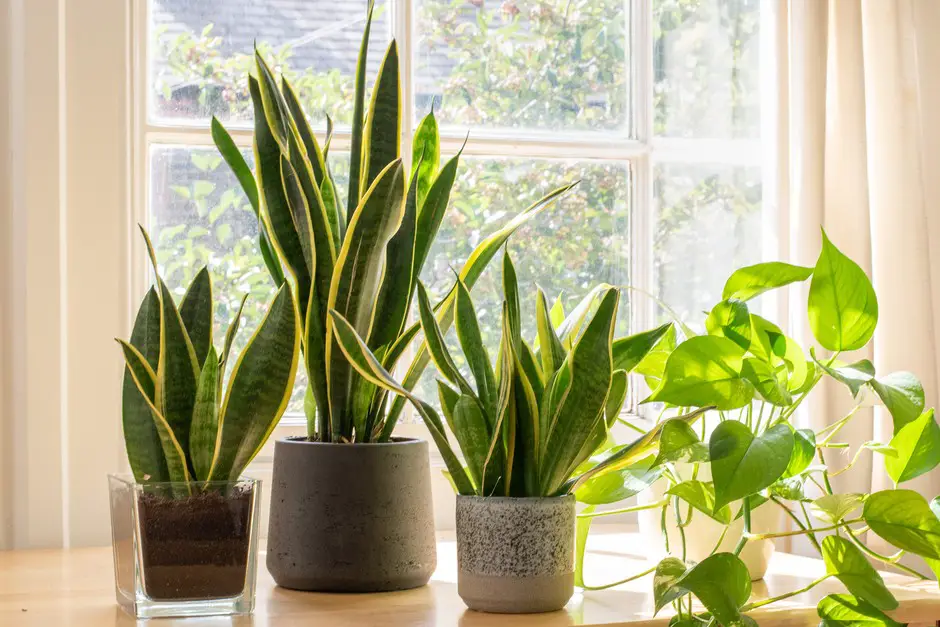
The Snake Plant (Sansevieria) is one of the 17 Best Plants for Air Purification, thanks to its exceptional ability to filter out harmful toxins like formaldehyde, benzene, and xylene. Unlike most plants, it continues to purify the air even at night by releasing oxygen, making it an excellent choice for bedrooms. Its striking, upright leaves add a modern touch to any space while requiring minimal care, making it ideal for beginners.
Why Snake Plant is One of the 17 Best Plants for Air Purification:
- Removes indoor pollutants like formaldehyde, benzene, and trichloroethylene.
- Releases oxygen at night, improving air quality while you sleep.
- Extremely low-maintenance and drought-tolerant, perfect for busy plant owners.
Care Tips for Snake Plant:
- Light: Thrives in indirect light but can tolerate low light and even some direct sunlight.
- Watering: Allow the soil to dry completely between watering. Overwatering can cause root rot, so water every 2–3 weeks.
- Soil: Use a well-draining potting mix, such as a cactus or succulent blend.
- Temperature & Humidity: Prefers temperatures between 60–80°F (16–27°C) and adapts well to dry indoor air.
- Fertilizing: Feed with a diluted liquid fertilizer once every 1–2 months during the growing season (spring and summer).
- Propagation: Easily propagated through leaf cuttings or division, making it easy to expand your plant collection.
As one of the 17 Best Plants for Air Purification, the Snake Plant is a fantastic addition to homes and offices, helping to create a fresher and healthier indoor environment with minimal effort.
2. Peace Lily (Spathiphyllum)
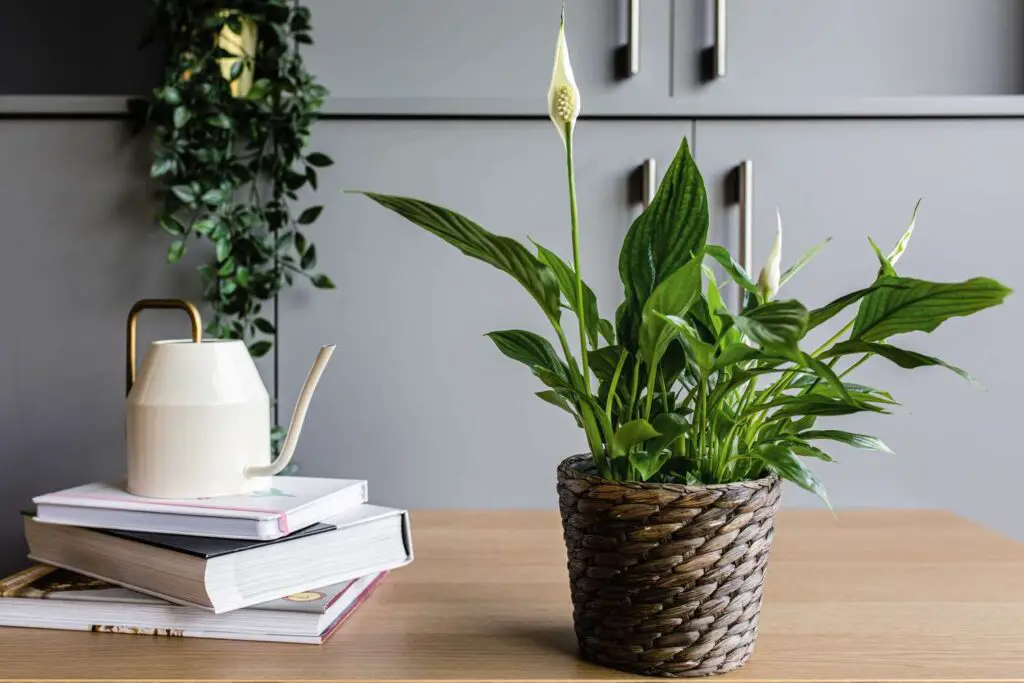
The Peace Lily (Spathiphyllum) is one of the 17 Best Plants for Air Purification, known for its elegant white blooms and powerful air-cleaning abilities. This beautiful plant effectively removes indoor toxins like ammonia, formaldehyde, benzene, and trichloroethylene, making it a great addition to homes and offices. Its lush green leaves and graceful flowers add a touch of elegance while improving indoor air quality.
Why Peace Lily is One of the 17 Best Plants for Air Purification:
- Filters harmful toxins like ammonia, benzene, and formaldehyde from indoor air.
- Increases humidity, which can help reduce dry skin and respiratory issues.
- Thrives in indoor environments and requires minimal care.
Care Tips for Peace Lily:
- Light: Prefers medium to bright indirect light but can tolerate low light. Too much direct sun can scorch its leaves.
- Watering: Keep the soil consistently moist but not soggy. Water when the top inch of soil feels dry.
- Soil: Use a well-draining potting mix with good moisture retention.
- Temperature & Humidity: Thrives in temperatures between 65–80°F (18–27°C) and enjoys higher humidity levels.
- Fertilizing: Feed with a balanced liquid fertilizer once a month during spring and summer.
- Propagation: Easily propagated by dividing the plant at the roots.
As one of the 17 Best Plants for Air Purification, the Peace Lily is not only a stunning houseplant but also an effective natural air purifier, promoting a cleaner and healthier living space.
3. Spider Plant (Chlorophytum comosum)

The Spider Plant (Chlorophytum comosum) is one of the 17 Best Plants for Air Purification, admired for its cascading green-and-white striped leaves and easy-care nature. This resilient houseplant is a powerful air purifier, effectively removing carbon monoxide, benzene, formaldehyde, and xylene from indoor air. It’s also pet-friendly, making it a safe and stylish choice for households with cats or dogs.
Why Spider Plant is One of the 17 Best Plants for Air Purification:
- Removes airborne toxins like carbon monoxide and benzene, improving air quality.
- Produces oxygen and increases humidity, reducing dryness in indoor spaces.
- Grows quickly and produces “spiderettes,” which can be propagated easily.
Care Tips for Spider Plant:
- Light: Thrives in bright, indirect sunlight but can tolerate low light. Avoid prolonged direct sun, which may scorch the leaves.
- Watering: Water occasionally when the top inch of soil feels dry. It is drought-tolerant but prefers slightly moist soil.
- Soil: Prefers well-draining potting mix with good aeration.
- Temperature & Humidity: Thrives in temperatures between 60–80°F (16–27°C) and enjoys moderate humidity.
- Fertilizing: Feed with a balanced liquid fertilizer once a month during the growing season (spring and summer).
- Propagation: Easily propagated through “spiderettes” (baby plants) that develop on long stems.
As one of the 17 Best Plants for Air Purification, the Spider Plant is a fantastic choice for beginners, requiring minimal maintenance while providing cleaner, fresher air indoors.
4. Boston Fern (Nephrolepis exaltata)
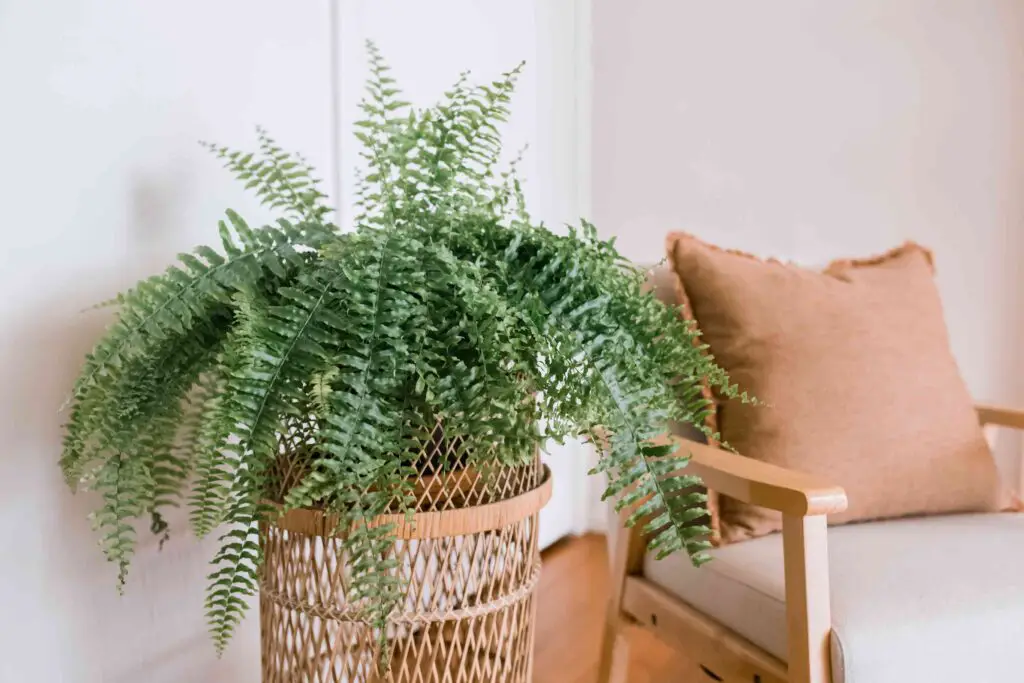
The Boston Fern (Nephrolepis exaltata) is one of the 17 Best Plants for Air Purification, bringing a lush, tropical feel to any indoor space while improving air quality. This elegant fern is particularly effective at increasing humidity and removing airborne toxins like formaldehyde and xylene, making it a great choice for homes prone to dry air. Its feathery fronds not only enhance décor but also contribute to a healthier living environment.
Why Boston Fern is One of the 17 Best Plants for Air Purification:
- Increases indoor humidity, helping with dry skin and respiratory health.
- Removes airborne pollutants such as formaldehyde and xylene.
- Enhances home aesthetics with its soft, cascading fronds.
Care Tips for Boston Fern:
- Light: Prefers bright, indirect light but can tolerate some shade. Avoid direct sunlight, which can scorch the leaves.
- Watering: Keep the soil consistently moist but not soggy. Water regularly, especially in warm, dry conditions.
- Soil: Use a rich, well-draining potting mix with good moisture retention.
- Temperature & Humidity: Thrives in temperatures between 60–75°F (16–24°C) and loves high humidity. Consider misting the leaves or using a humidity tray.
- Fertilizing: Feed with a diluted liquid fertilizer once a month during spring and summer.
- Propagation: Easily propagated by dividing the plant at the roots.
As one of the 17 Best Plants for Air Purification, the Boston Fern is an excellent choice for those looking to add beauty, humidity, and fresh air to their indoor environment.
5. Aloe Vera
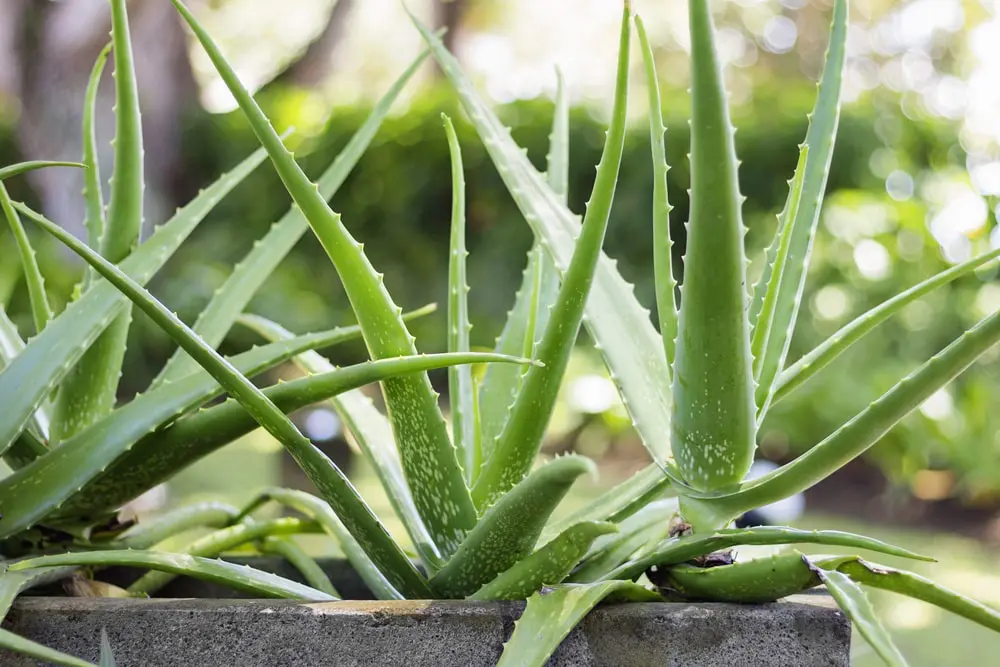
The Aloe Vera plant is one of the 17 Best Plants for Air Purification, celebrated not only for its air-cleaning abilities but also for its medicinal properties. This succulent effectively removes toxins like formaldehyde and benzene while adding a sleek, modern touch to any space. Its thick, fleshy leaves store water, making it incredibly low-maintenance and perfect for small spaces like desks, windowsills, and countertops.
Why Aloe Vera is One of the 17 Best Plants for Air Purification:
- Filters indoor air pollutants like formaldehyde and benzene.
- Doubles as a natural remedy for burns, cuts, and skin irritation.
- Thrives in small spaces, making it great for apartments or offices.
Care Tips for Aloe Vera:
- Light: Prefers bright, indirect sunlight but can tolerate some direct sun. A sunny windowsill is ideal.
- Watering: Water sparingly, allowing the soil to dry completely between waterings. Overwatering can cause root rot.
- Soil: Use a well-draining, sandy cactus or succulent mix.
- Temperature & Humidity: Prefers warm temperatures between 65–85°F (18–29°C) and does well in dry indoor air.
- Fertilizing: Feed with a diluted succulent fertilizer once every 1–2 months during spring and summer.
- Propagation: Easily propagated through pups (baby plants) that grow around the base.
As one of the 17 Best Plants for Air Purification, Aloe Vera is the perfect blend of functionality and beauty, purifying the air while serving as a natural healing plant.
Related Topics:
6. Rubber Plant (Ficus elastica)
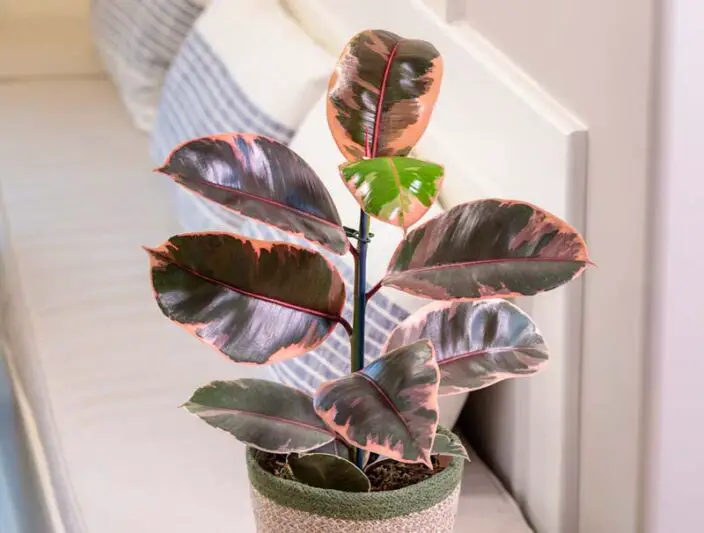
The Rubber Plant (Ficus elastica) is one of the 17 Best Plants for Air Purification, known for its broad, glossy leaves that make a stylish statement while effectively filtering indoor toxins. It is particularly powerful at removing formaldehyde, carbon monoxide, and other airborne pollutants, improving overall air quality. This hardy plant is low-maintenance and thrives in a variety of indoor environments, making it a great choice for both homes and offices.
Why Rubber Plant is One of the 17 Best Plants for Air Purification:
- Absorbs toxins like formaldehyde and carbon monoxide, promoting cleaner air.
- Produces high oxygen levels, enhancing indoor freshness.
- Striking foliage adds a bold, modern touch to any space.
Care Tips for Rubber Plant:
- Light: Prefers medium to bright indirect light but can adapt to lower light conditions. Avoid prolonged direct sunlight to prevent leaf scorch.
- Watering: Water when the soil feels dry to the touch. Overwatering can lead to root rot, so ensure proper drainage.
- Soil: Thrives in well-draining, rich potting soil.
- Temperature & Humidity: Prefers temperatures between 60–80°F (16–27°C) and enjoys moderate humidity.
- Fertilizing: Feed with a balanced liquid fertilizer once a month during the growing season (spring and summer).
- Propagation: Can be propagated through stem cuttings in water or soil.
As one of the 17 Best Plants for Air Purification, the Rubber Plant is both an air-cleansing powerhouse and a visually stunning addition to any indoor space.
7. Monstera Deliciosa
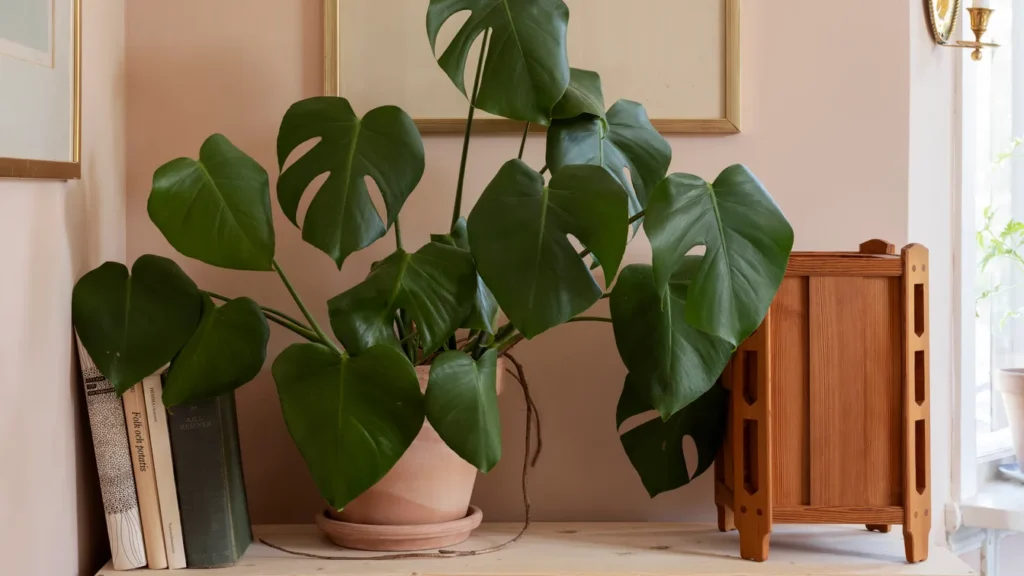
The Monstera Deliciosa, also known as the Swiss Cheese Plant, is one of the 17 Best Plants for Air Purification, admired for its unique, split leaves and impressive air-cleansing properties. This tropical beauty helps remove toxins like formaldehyde and benzene while adding a lush, jungle-like vibe to any space. Its large, glossy leaves not only make a bold decor statement but also contribute to better indoor air quality.
Why Monstera Deliciosa is One of the 17 Best Plants for Air Purification:
- Filters toxins like formaldehyde and benzene from indoor air.
- Boosts oxygen levels, promoting a fresher home environment.
- Fast-growing and easy to maintain, perfect for indoor decor.
Care Tips for Monstera Deliciosa:
- Light: Prefers bright, indirect sunlight but can tolerate some shade. Avoid harsh direct sunlight, which may scorch its leaves.
- Watering: Water weekly, allowing the top inch of soil to dry out between waterings. Avoid overwatering to prevent root rot.
- Soil: Thrives in well-draining, nutrient-rich potting soil.
- Temperature & Humidity: Loves warm temperatures between 65–85°F (18–29°C) and thrives in high humidity. Mist the leaves occasionally for added moisture.
- Fertilizing: Feed with a balanced liquid fertilizer once a month during the growing season (spring and summer).
- Propagation: Easily propagated through stem cuttings placed in water or soil.
As one of the 17 Best Plants for Air Purification, Monstera Deliciosa is the perfect blend of beauty and function, making it a must-have for plant lovers looking to enhance both their decor and air quality.
8. Areca Palm (Dypsis lutescens)
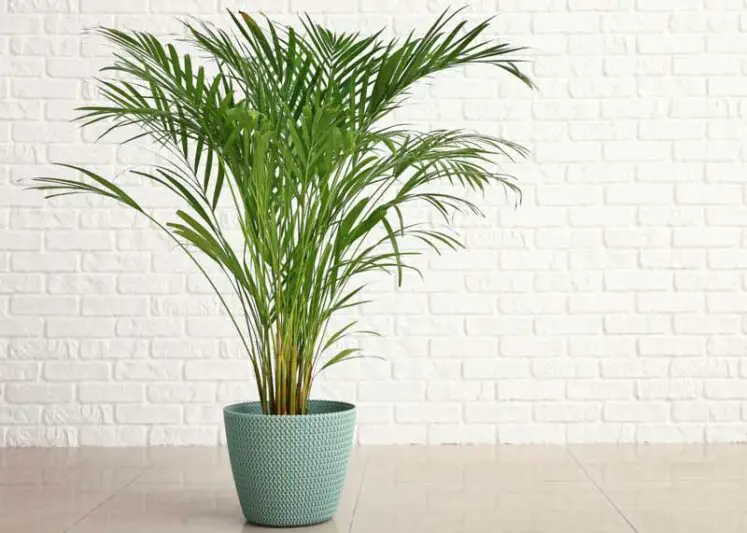
The Areca Palm (Dypsis lutescens) is one of the 17 Best Plants for Air Purification, prized for its lush, feathery fronds and ability to naturally filter indoor air. This tropical palm is particularly effective at removing toxins like xylene and toluene while increasing humidity levels, making it an excellent choice for improving air quality in dry indoor spaces. Its graceful appearance makes it a perfect statement plant for homes and offices.
Why Areca Palm is One of the 17 Best Plants for Air Purification:
- Removes toxins like xylene, toluene, and formaldehyde from the air.
- Boosts indoor humidity, making it great for those with dry skin or respiratory issues.
- Adds a tropical, elegant touch to any room.
Care Tips for Areca Palm:
- Light: Thrives in bright, indirect sunlight. Can tolerate some direct morning light but avoid harsh afternoon sun.
- Watering: Water regularly, keeping the soil slightly moist but not soggy. Allow the top inch of soil to dry out between waterings.
- Soil: Prefers well-draining, peat-based potting mix.
- Temperature & Humidity: Loves warm temperatures between 65–80°F (18–27°C) and thrives in high humidity. Mist the leaves occasionally to maintain moisture.
- Fertilizing: Feed with a balanced liquid fertilizer once a month during the growing season (spring and summer).
- Propagation: Can be propagated through division of clumps or by planting seeds, though it grows slowly.
As one of the 17 Best Plants for Air Purification, the Areca Palm is a stunning, low-maintenance plant that purifies the air while creating a relaxing, tropical atmosphere indoors.
9. Dracaena
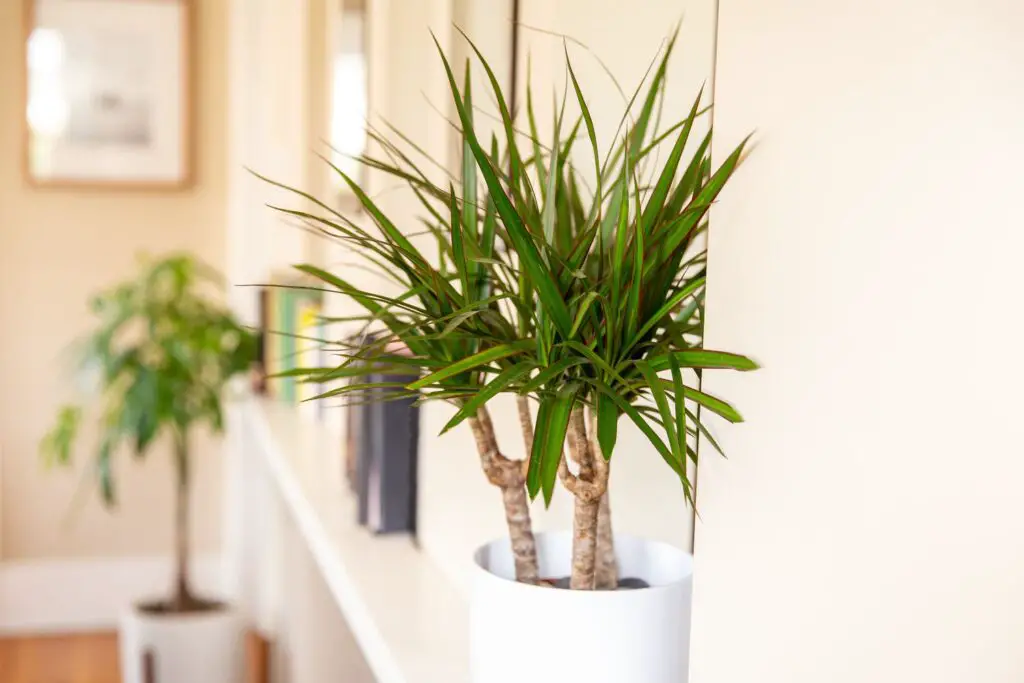
The Dracaena is one of the 17 Best Plants for Air Purification, valued for its striking foliage and powerful air-filtering abilities. With its long, arching leaves and variety of colors, this plant adds a lively touch to any space while removing harmful toxins such as benzene, trichloroethylene, and formaldehyde. Dracaena is also easy to care for, making it a fantastic choice for both beginner and experienced plant owners.
Why Dracaena is One of the 17 Best Plants for Air Purification:
- Effectively removes airborne toxins like benzene, formaldehyde, and trichloroethylene.
- Increases humidity levels, helping to reduce dryness in indoor air.
- Comes in various species with different leaf patterns and colors, offering versatility in decor.
Care Tips for Dracaena:
- Light: Prefers indirect sunlight but can tolerate low-light conditions. Avoid direct sunlight, which may scorch the leaves.
- Watering: Keep the soil slightly damp, allowing the top layer to dry out between waterings. Overwatering can lead to root rot.
- Soil: Thrives in well-draining, nutrient-rich potting soil.
- Temperature & Humidity: Grows best in temperatures between 65–80°F (18–27°C) with moderate humidity.
- Fertilizing: Feed with a balanced liquid fertilizer every 4–6 weeks during the growing season (spring and summer).
- Propagation: Can be propagated through stem cuttings placed in water or soil.
As one of the 17 Best Plants for Air Purification, the Dracaena is a beautiful and functional addition to any indoor space, improving air quality while adding a vibrant, lush aesthetic.
10. Pothos (Epipremnum aureum)
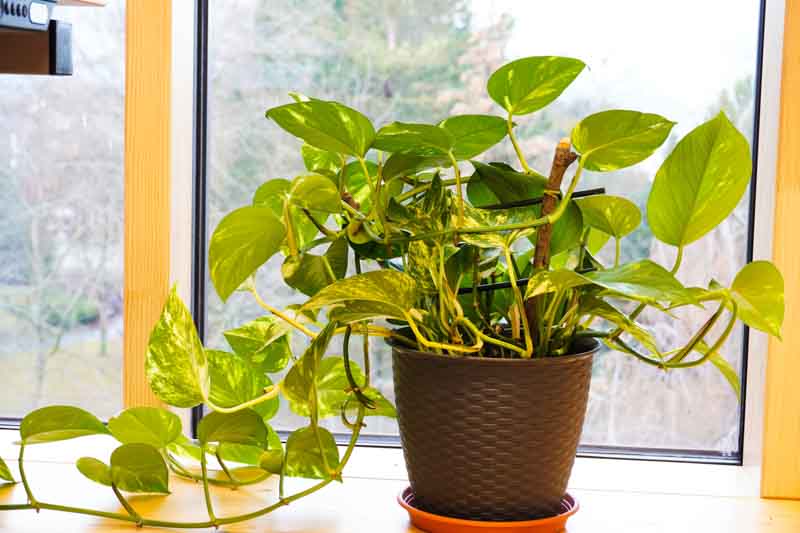
The Pothos (Epipremnum aureum), also known as Devil’s Ivy, is one of the 17 Best Plants for Air Purification due to its ability to thrive in almost any indoor environment while removing harmful toxins. This trailing vine is not only low-maintenance but also highly effective at filtering out pollutants like formaldehyde, benzene, and carbon monoxide. With its cascading vines and heart-shaped leaves, pothos is a versatile plant that adds greenery to shelves, hanging baskets, or desktops.
Why Pothos is One of the 17 Best Plants for Air Purification:
- Removes indoor toxins like formaldehyde, benzene, and xylene.
- Thrives in low light conditions, making it perfect for offices and apartments.
- Easy to care for and highly adaptable to different environments.
Care Tips for Pothos:
- Light: Prefers indirect light but can adapt to low light or fluorescent lighting. Avoid prolonged direct sunlight.
- Watering: Requires minimal watering—allow the soil to dry out between waterings to prevent root rot.
- Soil: Grows well in well-draining potting mix or even just water.
- Temperature & Humidity: Thrives in temperatures between 65–85°F (18–29°C) and enjoys moderate humidity.
- Fertilizing: Feed with a balanced liquid fertilizer every 4–6 weeks during spring and summer.
- Propagation: Easily propagated through stem cuttings placed in water or soil.
As one of the 17 Best Plants for Air Purification, Pothos is the perfect low-maintenance plant for those looking to improve air quality while adding a touch of greenery to their indoor space.
11. Bamboo Palm (Chamaedorea seifrizii)
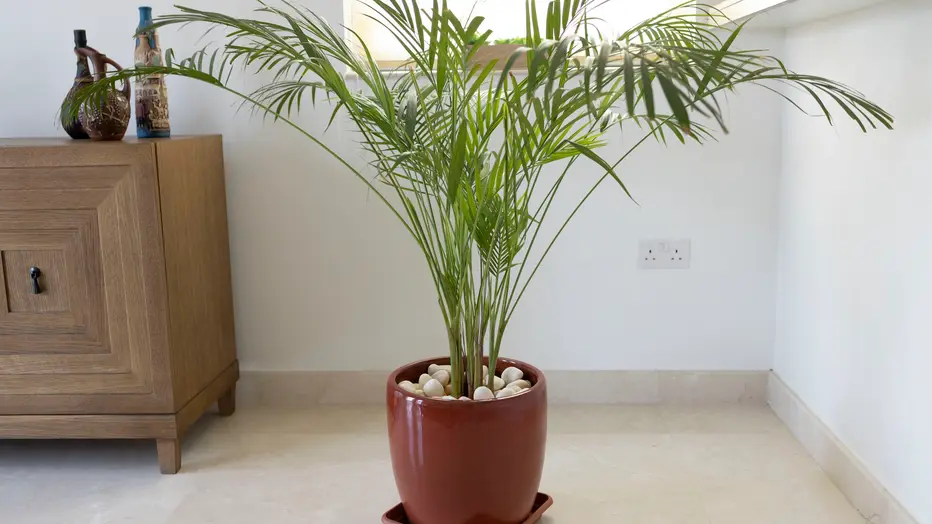
The Bamboo Palm (Chamaedorea seifrizii) is one of the 17 Best Plants for Air Purification, admired for its elegant, feathery fronds and powerful ability to remove toxins from the air. This tropical beauty is particularly effective at filtering carbon dioxide, formaldehyde, and benzene, making it an excellent addition to homes and offices. It also increases humidity levels, helping to keep indoor air fresh and breathable.
Why Bamboo Palm is One of the 17 Best Plants for Air Purification:
- Removes toxins like formaldehyde, carbon dioxide, and benzene.
- Adds humidity to the air, reducing dryness and improving air quality.
- Low-maintenance and pet-friendly, making it a great choice for households with animals.
Care Tips for Bamboo Palm:
- Light: Prefers bright, indirect light, though it can tolerate some low-light conditions. Avoid direct sunlight, which can scorch its leaves.
- Watering: Keep the soil evenly moist but not soggy. Water when the top inch of soil feels dry.
- Soil: Thrives in well-draining, rich potting mix.
- Temperature & Humidity: Grows best in temperatures between 65–80°F (18–27°C) and enjoys moderate to high humidity.
- Fertilizing: Feed with a balanced liquid fertilizer every 4–6 weeks during the growing season (spring and summer).
- Propagation: Can be propagated through division of clumps or by seeds, though it grows slowly.
As one of the 17 Best Plants for Air Purification, the Bamboo Palm is an attractive, air-purifying plant that enhances indoor spaces while contributing to a healthier environment.
12. Philodendron
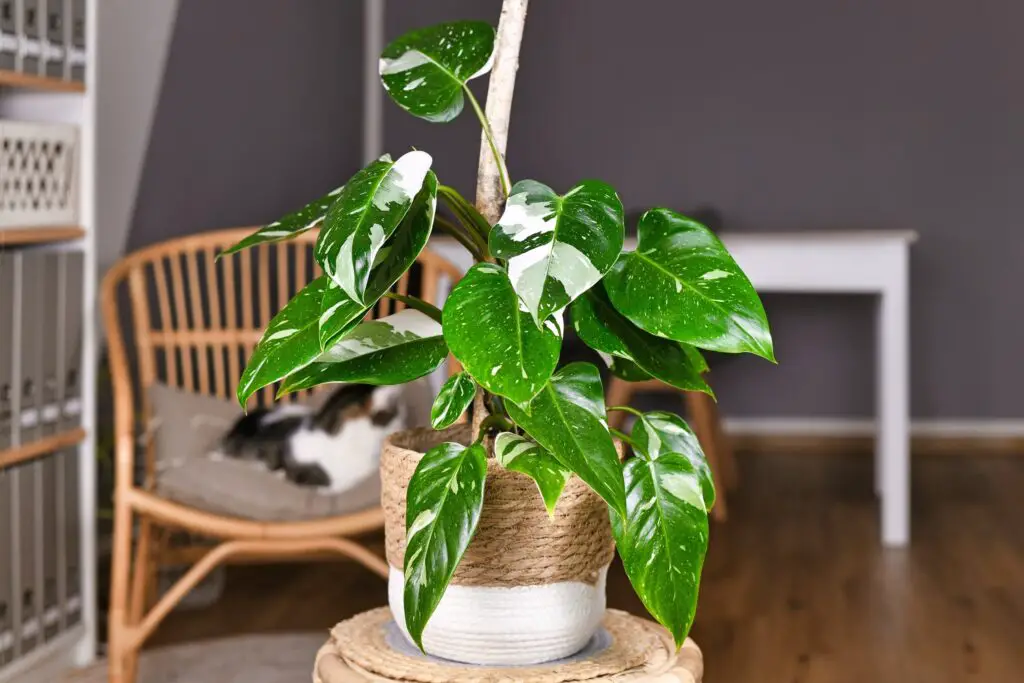
The Philodendron is one of the 17 Best Plants for Air Purification, known for its lush, trailing vines and broad, glossy leaves. Whether you choose the Heartleaf Philodendron (Philodendron hederaceum) or the Split-Leaf Philodendron (Philodendron bipinnatifidum), this plant is both aesthetically pleasing and highly effective at removing toxins such as formaldehyde from indoor air. Its adaptable nature makes it an easy-care favorite for homes and offices alike.
Why Philodendron is One of the 17 Best Plants for Air Purification:
- Filters toxins like formaldehyde, helping to improve indoor air quality.
- Grows quickly and adapts well to a variety of indoor conditions.
- Available in trailing or upright varieties, making it versatile for different spaces.
Care Tips for Philodendron:
- Light: Prefers filtered sunlight or bright, indirect light but can tolerate low-light conditions. Avoid prolonged direct sunlight to prevent leaf scorch.
- Watering: Water sparingly, allowing the top inch of soil to dry out between waterings. Overwatering can lead to root rot.
- Soil: Thrives in well-draining, nutrient-rich potting mix.
- Temperature & Humidity: Best suited for temperatures between 65–80°F (18–27°C) with moderate humidity.
- Fertilizing: Feed with a balanced liquid fertilizer once a month during spring and summer for optimal growth.
- Propagation: Easily propagated through stem cuttings placed in water or soil.
As one of the 17 Best Plants for Air Purification, the Philodendron is a stunning and effective air-purifying plant that requires minimal effort while enhancing indoor greenery.
13. English Ivy (Hedera helix)

The English Ivy (Hedera helix) is one of the 17 Best Plants for Air Purification, renowned for its ability to filter airborne toxins and reduce indoor mold levels. This trailing plant is particularly effective in bathrooms and damp environments, where it helps eliminate mold spores and airborne fecal matter particles, improving air quality. With its elegant, cascading vines, English ivy makes a great addition to hanging baskets or shelves.
Why English Ivy is One of the 17 Best Plants for Air Purification:
- Reduces airborne mold and fecal matter particles, making it ideal for bathrooms and kitchens.
- Filters toxins like benzene, formaldehyde, and trichloroethylene from indoor air.
- Adaptable and decorative, with trailing vines that enhance any space.
Care Tips for English Ivy:
- Light: Prefers bright, indirect light, though it can tolerate low light. Avoid harsh direct sunlight, which may scorch the leaves.
- Watering: Keep the soil moist but not soggy. Water when the top inch of soil starts to dry out.
- Soil: Thrives in well-draining, rich potting mix with good aeration.
- Temperature & Humidity: Grows best in temperatures between 50–75°F (10–24°C) and enjoys moderate humidity. Mist occasionally if indoor air is dry.
- Fertilizing: Feed with a balanced liquid fertilizer every 4–6 weeks during the growing season (spring and summer).
- Propagation: Easily propagated through stem cuttings placed in water or soil.
As one of the 17 Best Plants for Air Purification, English Ivy is an excellent choice for improving air quality, especially in humid areas where mold may be a concern. Its elegant trailing vines also add a touch of greenery to any indoor setting.
14. Chinese Evergreen (Aglaonema)
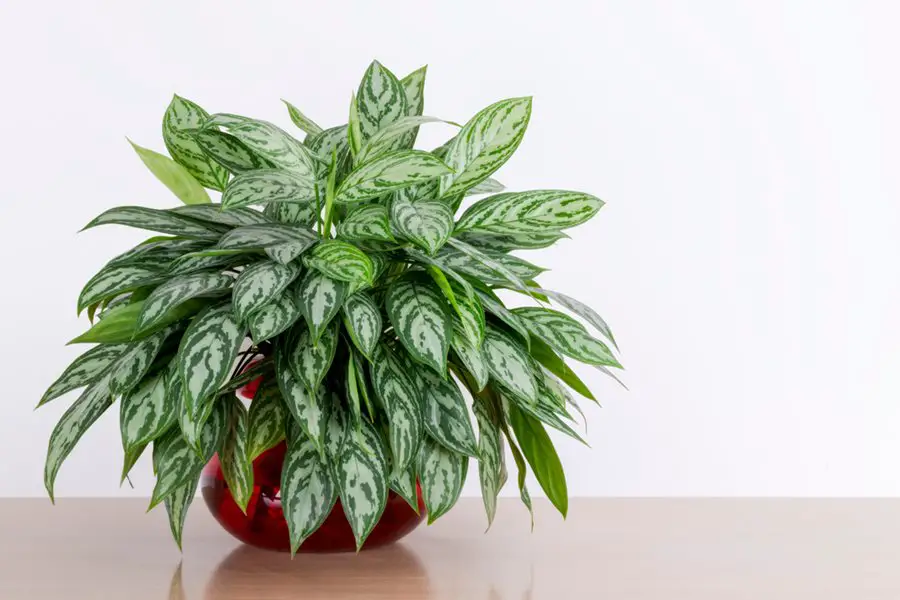
The Chinese Evergreen (Aglaonema) is one of the 17 Best Plants for Air Purification, loved for its adaptability and striking foliage. This resilient plant efficiently filters indoor air by removing toxins like benzene and formaldehyde while adding a pop of color with its vibrant, patterned leaves. Whether you’re a beginner or a seasoned plant parent, Aglaonema is an easy-to-care-for choice that thrives in a variety of indoor conditions.
Why Chinese Evergreen is One of the 17 Best Plants for Air Purification:
- Effectively removes harmful toxins like formaldehyde and benzene.
- Thrives in low to medium light, making it perfect for offices and shaded rooms.
- Comes in stunning varieties with green, silver, or red-tinged leaves.
Care Tips for Chinese Evergreen:
- Light: Prefers low to medium light but can tolerate artificial lighting. Avoid direct sunlight, which can scorch its leaves.
- Watering: Water when the soil is dry to the touch. Avoid overwatering to prevent root rot.
- Soil: Grows well in a well-draining, peat-based potting mix.
- Temperature & Humidity: Thrives in warm temperatures between 65–80°F (18–27°C) and prefers moderate humidity.
- Fertilizing: Feed with a balanced liquid fertilizer every 6–8 weeks during the growing season (spring and summer).
- Propagation: Can be propagated through stem cuttings or division of root clumps.
As one of the 17 Best Plants for Air Purification, the Chinese Evergreen is a perfect low-maintenance plant that not only improves air quality but also enhances the beauty of any indoor space.
15. Weeping Fig (Ficus benjamina)
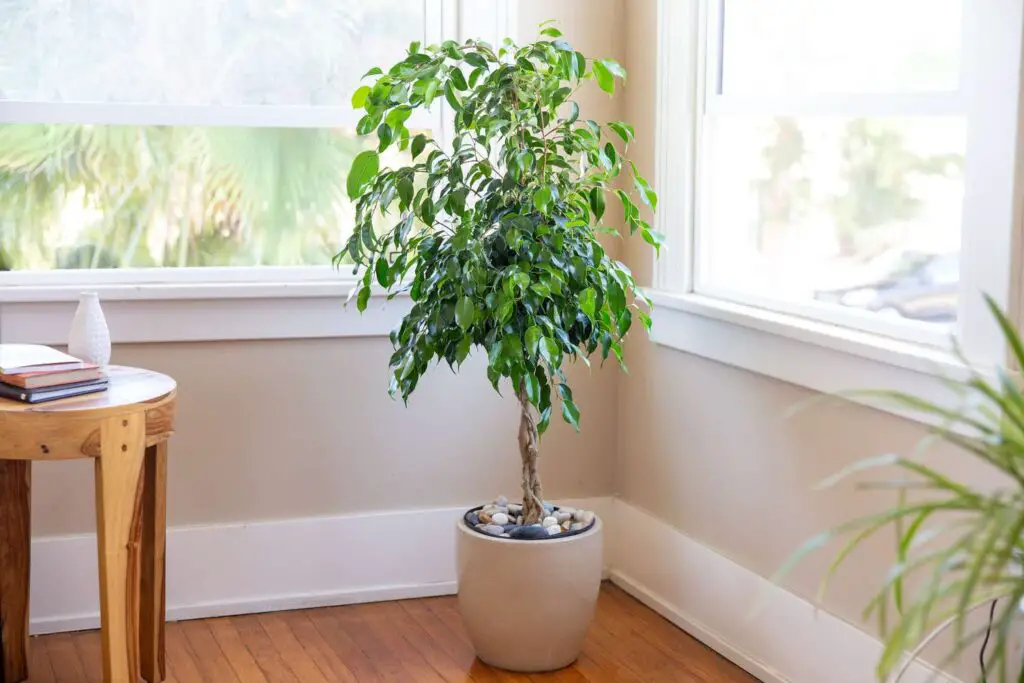
The Weeping Fig (Ficus benjamina) is one of the 17 Best Plants for Air Purification, admired for its graceful, arching branches and lush foliage. This popular indoor tree effectively removes toxins such as formaldehyde, benzene, and trichloroethylene, making it an excellent choice for improving indoor air quality. With its elegant appearance, the Weeping Fig is a stunning focal point in homes and offices.
Why Weeping Fig is One of the 17 Best Plants for Air Purification:
- Filters common indoor pollutants, including formaldehyde, benzene, and trichloroethylene.
- Acts as a natural humidifier, improving indoor air quality.
- Adds an elegant touch to any space with its delicate, drooping leaves.
Care Tips for Weeping Fig:
- Light: Prefers bright, indirect sunlight but can adapt to partial shade. Avoid sudden light changes, as this can cause leaf drop.
- Watering: Water when the soil feels dry, allowing the top inch to dry out before watering again. Avoid overwatering to prevent root rot.
- Soil: Thrives in well-draining, nutrient-rich potting soil.
- Temperature & Humidity: Best suited for temperatures between 65–75°F (18–24°C) and enjoys moderate humidity. Keep away from drafts.
- Fertilizing: Feed with a balanced liquid fertilizer every 4–6 weeks during spring and summer.
- Pruning & Maintenance: Prune occasionally to maintain shape and encourage bushy growth. Avoid frequent relocation, as it can lead to leaf drop.
As one of the 17 Best Plants for Air Purification, the Weeping Fig is a timeless and effective air-purifying plant that enhances indoor spaces with its refined beauty while keeping the air fresh and clean.
16. Golden Cane Palm (Dypsis lutescens)
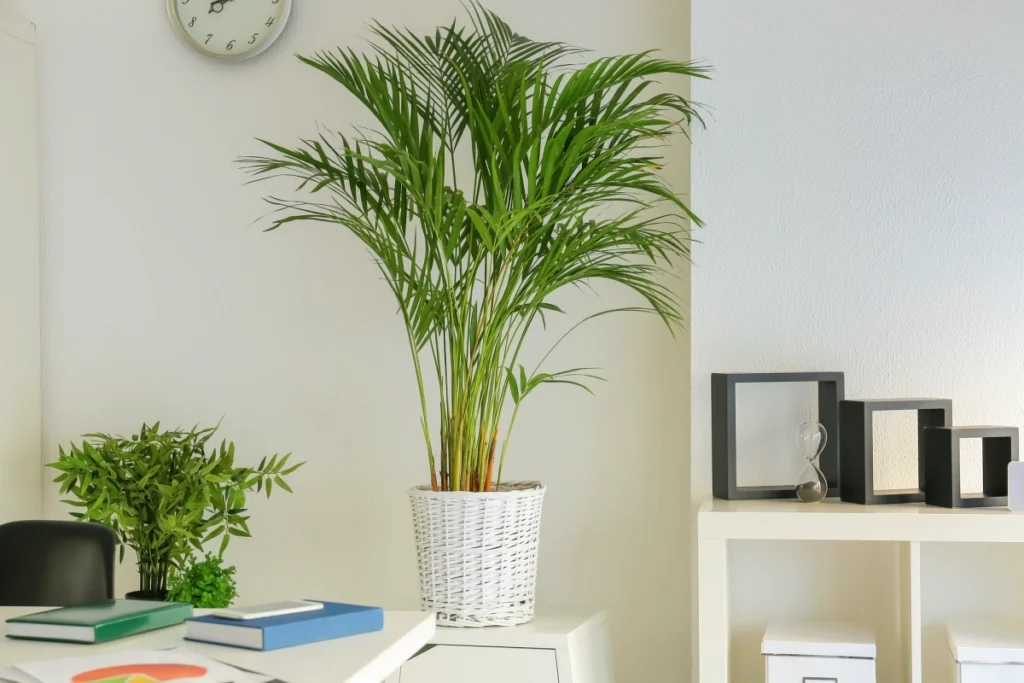
The Golden Cane Palm (Dypsis lutescens), also known as the Areca Palm, is one of the 17 Best Plants for Air Purification, valued for its ability to remove toxins while adding a tropical touch to any space. This tall, feathery palm is particularly effective at increasing humidity and filtering out harmful pollutants like benzene, carbon monoxide, and formaldehyde, making it ideal for large indoor areas.
Why Golden Cane Palm is One of the 17 Best Plants for Air Purification:
- Acts as a natural humidifier, improving air moisture levels.
- Filters indoor toxins such as formaldehyde, carbon monoxide, and benzene.
- Adds a lush, tropical aesthetic to homes and offices.
Care Tips for Golden Cane Palm:
- Light: Prefers bright, indirect light, though it can tolerate some direct sunlight.
- Watering: Keep the soil consistently moist, but avoid waterlogging. Water when the top inch of soil feels dry.
- Soil: Thrives in a well-draining, rich potting mix.
- Temperature & Humidity: Best suited for temperatures between 65–80°F (18–27°C) and prefers moderate to high humidity.
- Fertilizing: Feed with a balanced liquid fertilizer every 4–6 weeks during the growing season (spring and summer).
- Pruning & Maintenance: Remove yellow or brown fronds to keep the plant looking fresh and healthy.
As one of the 17 Best Plants for Air Purification, the Golden Cane Palm is an excellent choice for those looking to enhance indoor air quality while bringing a refreshing, tropical vibe to their space.
17. Parlor Palm (Chamaedorea elegans)
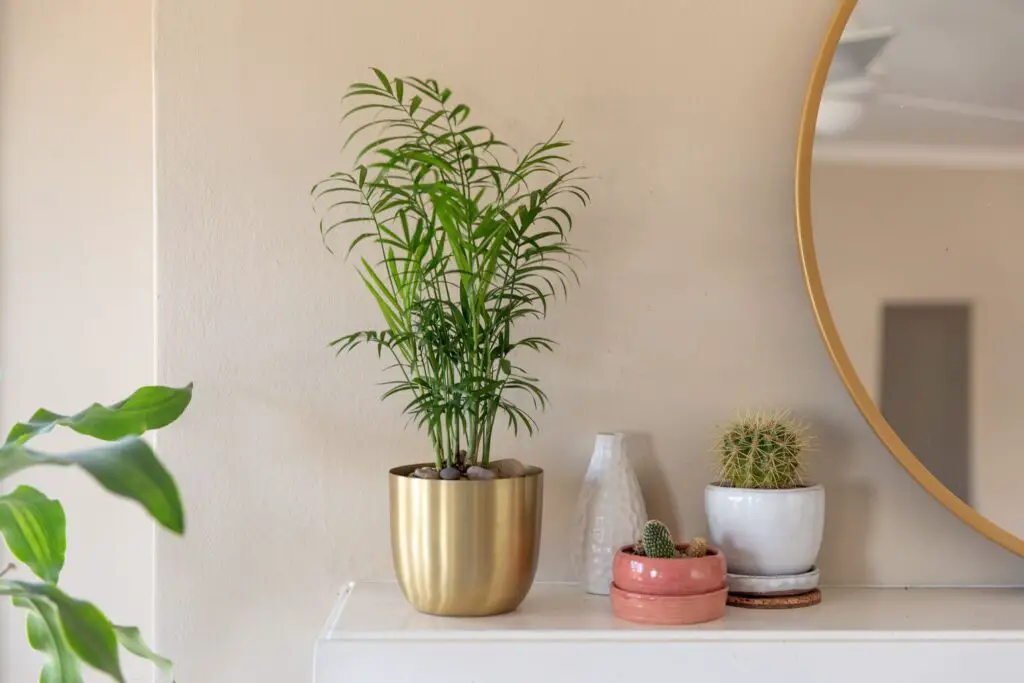
The Parlor Palm (Chamaedorea elegans) is a beautiful and effective plant in the 17 Best Plants for Air Purification. Known for its sleek, arching fronds, the Parlor Palm is a favorite among indoor plant enthusiasts. Not only does it add a touch of tropical elegance to any space, but it also excels at purifying the air by removing toxins like formaldehyde and benzene. This plant thrives in a variety of indoor environments, making it an excellent choice for bedrooms, offices, and living rooms.
Why Parlor Palm is One of the 17 Best Plants for Air Purification:
- Removes toxins such as formaldehyde, benzene, and trichloroethylene from the air.
- Tolerates low light, making it a versatile plant for spaces with limited natural light.
- Adds elegance to any room with its graceful, feathery fronds.
Care Tips for Parlor Palm:
- Light: Prefers low to medium light and can tolerate some low-light conditions. Avoid direct sunlight, which can scorch the leaves.
- Watering: Keep the soil moist but not soggy. Water when the top inch of soil feels dry, ensuring the plant doesn’t sit in standing water.
- Soil: Thrives in well-draining, peat-based potting mix.
- Temperature & Humidity: Best in temperatures between 65–80°F (18–27°C) and enjoys moderate to high humidity.
- Fertilizing: Feed with a balanced liquid fertilizer every 4–6 weeks during the growing season (spring and summer).
- Pruning & Maintenance: Remove any yellow or dead fronds to keep the plant looking healthy and vibrant.
As one of the 17 Best Plants for Air Purification, the Parlor Palm is not only a natural air purifier but also a charming addition to any indoor space, helping to create a fresher, more breathable atmosphere.
How to Get Started
If you’re new to plant care, consider starting with low-maintenance options like the snake plant or spider plant. Gradually work your way to more demanding plants like the Boston Fern or Peace Lily.
Pro Tips:
- Rotate your plants to give them equal exposure to light.
- Don’t overwater! Many houseplant woes start with too much water.
- Use well-draining potting soil and make sure your pots have proper drainage holes.
Incorporating air-purifying plants into your home or office is a natural and stylish way to improve indoor air quality while adding a touch of greenery. The 17 Best Plants for Air Purification—ranging from hardy options like the Snake Plant and Pothos to tropical beauties like the Areca Palm and Parlor Palm—are proven to filter out common pollutants such as formaldehyde, benzene, carbon monoxide, and trichloroethylene.
Beyond their air-cleansing abilities, these plants also increase humidity, reduce stress, and enhance overall well-being, making them perfect companions for any indoor space. Whether you’re a beginner or an experienced plant enthusiast, there’s a plant on this list to fit your lifestyle and brighten your environment.
By adding these 17 Best Plants for Air Purification to your space, you can enjoy fresher air, better health, and a more inviting home—one leaf at a time.
FAQs:
1. Which plant is the most effective at purifying indoor air?
All 17 Best Plants for Air Purification help remove toxins, but some of the most effective include the Snake Plant, Peace Lily, and Areca Palm. These plants are known to filter pollutants like formaldehyde, benzene, and carbon monoxide while also improving humidity levels.
2. Do air-purifying plants really improve indoor air quality?
Yes! Studies, including those by NASA, have shown that many indoor plants can help remove harmful toxins from the air. While they’re not a complete replacement for proper ventilation, air-purifying plants can enhance oxygen levels, absorb toxins, and increase humidity, making your home healthier.
3. How do I care for air-purifying plants to keep them effective?
Each plant has specific care needs, but in general:
- Provide the right light conditions (e.g., Snake Plants and Chinese Evergreens tolerate low light, while Palms and Monstera need bright, indirect light).
- Water appropriately (most plants prefer their soil to dry slightly between watering).
- Keep leaves clean to help the plant absorb pollutants more efficiently.
By following these simple care tips, your 17 Best Plants for Air Purification will thrive and keep your indoor air fresh and clean!

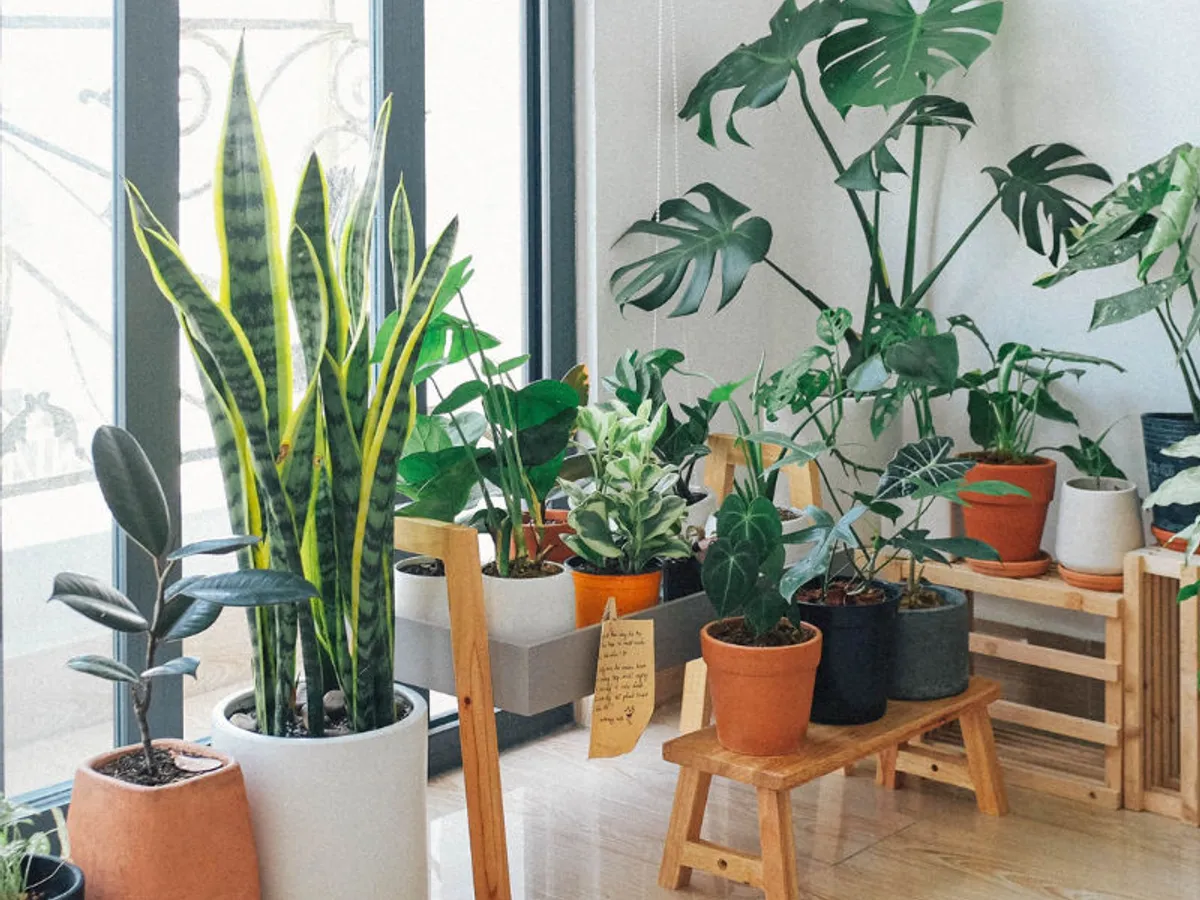
2 thoughts on “17 Best Plants For Air Purification: Fresher, Healthier Home!”